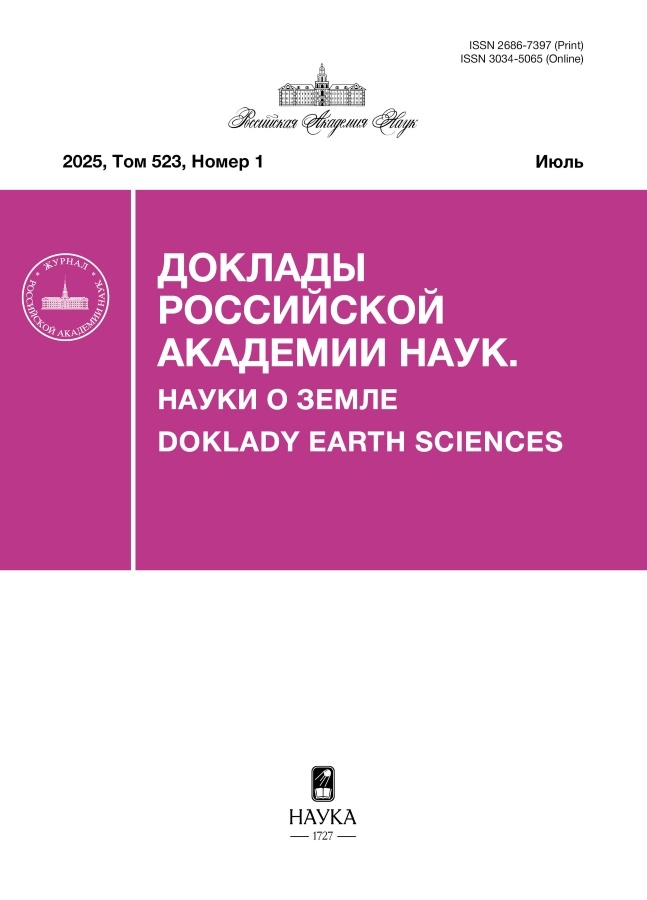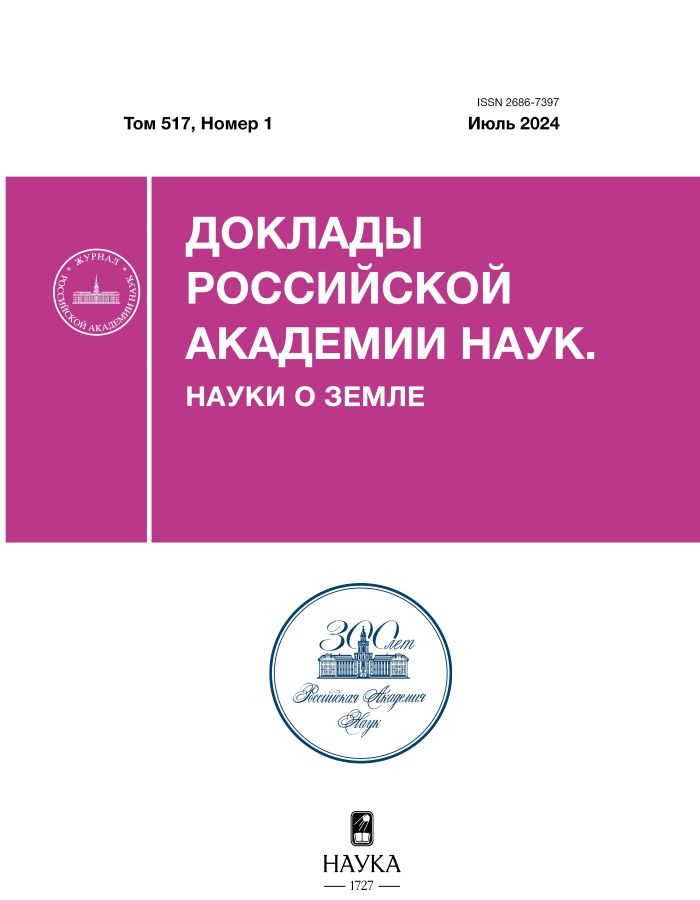Пространственная изменчивость параметров верхней границы зоны стабильности гидратов метана в водной толще Охотского моря
- Авторы: Шакиров Р.Б.1, Лучин В.А.1, Петрова Е.А.1
-
Учреждения:
- Тихоокеанский океанологический институт им. В.И. Ильичева Дальневосточного отделения Российской Академии наук
- Выпуск: Том 517, № 1 (2024)
- Страницы: 153-159
- Раздел: ОКЕАНОЛОГИЯ
- Статья получена: 31.01.2025
- Статья опубликована: 13.12.2024
- URL: https://edgccjournal.org/2686-7397/article/view/650011
- DOI: https://doi.org/10.31857/S2686739724070169
- ID: 650011
Цитировать
Полный текст
Аннотация
На основе всей доступной океанологической информации (131 286 станций, выполненных с 1929 по 2020 гг.) впервые для Охотского моря представлены пространственные закономерности распределения параметров верхней границы зоны стабильности гидратов метана (температура воды, солёность, глубина залегания верхней границы в водной толще). Рассмотрена модель зоны стабильности газогидратов (ЗСГГ), эквивалентная зоне стабильности гидратов метана. Показано, что в Охотском море минимальная температура воды и минимальное заглубление верхней границы зоны стабильности газогидратов (менее 1°С и 300–320 м соответственно) выделяются у восточного склона о-ва Сахалин. Максимальная температура воды и максимальное заглубление верхней границы (1.5–1.7°С и 340–350 м соответственно) характерны для района, прилегающего к центральным и северным проливам Курильской гряды, а также над склоном полуострова Камчатка. Значения солености на верхней границе ЗСГГ в Охотском море варьируют в довольно узких пределах от 33.4 до 33.6 psu, что достаточно близко к принятым нами условиям стабильности гидрата метана в морской воде. Выделена акватория, где в толще вод отсутствуют термобарические условия для формирования и существования гидратов метана.
Ключевые слова
Полный текст
Об авторах
Р. Б. Шакиров
Тихоокеанский океанологический институт им. В.И. Ильичева Дальневосточного отделения Российской Академии наук
Email: petrova@poi.dvo.ru
Россия, Владивосток
В. А. Лучин
Тихоокеанский океанологический институт им. В.И. Ильичева Дальневосточного отделения Российской Академии наук
Email: petrova@poi.dvo.ru
Россия, Владивосток
Е. А. Петрова
Тихоокеанский океанологический институт им. В.И. Ильичева Дальневосточного отделения Российской Академии наук
Автор, ответственный за переписку.
Email: petrova@poi.dvo.ru
Россия, Владивосток
Список литературы
- Макогон Ю. Ф. Газогидраты. История изучения и перспективы освоения // Геология и полезные ископаемые Мирового океана. 2010. № 2. С. 5–21.
- Reagan M. T., Moridis G. J., Elliott S. M., Maltrud M. Contribution of oceanic gas hydrate dissociation to the formation of Arctic Ocean methane plumes // J. Geophys. Res. 2011. V. 116. C09014.
- Трофимук А. А., Черский Н. В., Царев В. П. Особенности накопления природных газов в зонах гидратообразования Мирового океана // Доклады Академии наук СССР. 1973. Т. 212. № 4. С. 931–934.
- Метан и климатические изменения: научные проблемы и технологические аспекты / Под ред. акад. РАН В.Г. Бондура, акад. РАН И. И. Мохова, чл.-кор. РАН А. А. Макоско. М.: Российская академия наук, 2022. 388 с.
- Богоявленский В. И., Янчевская А. С., Богоявленский И. В., Кишанков А. В. Газовые гидраты на акваториях Циркумарктического региона // Арктика: экология и экономика. 2018. № 3(31). С. 42–55.
- Веселов О. В., Гордиенко В. В., Куделькин В. В. Термобарические условия формирования газогидратов в Охотском море // Геология и полезные ископаемые Мирового океана. 2006. № 3(5). С. 62–68.
- Chen Z., Bai W., Xu W. Prediction of stability zones and occurrence zones of multiple composition natural gas hydrate in marine sediments // Chinese Journal of Geophysics. 2005. V. 48. № 4. P. 936–945.
- Dickens G. R., Quinby-Hunt M. S. Methane hydrate stability in seawater // Geophys. Res. Lett. 1994. V. 21. № 19. P. 2115–2118.
- Елисеев А. В. Глобальный цикл метана: обзор // Фундаментальная и прикладная климатология. 2018. Т. 1. С. 52–70.
- Bogoyavlensky V., Kishankov A., Yanchevskaya A., Bogoyavlensky I. Forecast of Gas Hydrates Distribution Zones in the Arctic Ocean and Adjacent Offshore Areas // Geosciences. 2018. V. 8. № 12. P. 453. https://doi.org/10.3390/geosciences8120453
- McGinnis D. F., Greinert J., Artemov Y., Beaubien S. E., Wuest A. Fate of rising methane bubbles in stratified waters: How much methane reaches the atmosphere? // Journal of Geophysical Research. 2006. V. 111. C09007. https://doi.org/10.1029/2005JC003183.
- Granin N. G., Makarov M. M., Kucher K. M., Gnatovsky R. Y. Gas seeps in Lake Baikal-detection, distribution, and implications for water column mixing // Geo-Marine Letters. 2010. V. 30. № 3-4. P. 399–409. https://doi.org/10.1007/s00367-010-0201-3
- Biastoch A., Treude T., Rüpke L. H., Riebesell U., Roth C., Burwicz E. B., Park W., Latif M., Böning C. W., Madec G., Wallmann K. Rising Arctic Ocean temperatures cause gas hydrate destabilization and ocean acidification // Geophys. Res. Lett. 2011. V. 38. L08602. https://doi.org/10.1029/2011GL047222
- Giustiniani M., Tinivella U., Jakobsson M., Rebesco M. Arctic ocean gas hydrate stability in a changing climate // J. Geol. Res. 2013. V. 2013. 783969. https://doi.org/10.1155/2013/783969
- Reagan M. T., Moridis G. J. Oceanic gas hydrate instability and dissociation under climate change scenarios // Geophys. Res. Lett. 2007. V. 34. L22709. https://doi.org/10.1029/2007GL031671.
- Обжиров А. И., Шакиров Р. Б. Комплексные геолого-геофизические исследования газогидратов в Охотском море / В кн.: Геология и геоэкология континентальных окраин Евразии. Вып. 4. Специальный выпуск. Геология и полезные ископаемые окраинных морей Евразии. М.: ГЕОС, 2012. С. 122–136.
- Лучин В. А. Сезонная изменчивость температуры воды в деятельном слое дальневосточных морей / В кн.: Дальневосточные моря России. Т. 1. М.: Наука, 2007. С. 232–252.
- Морошкин К. В. Новая схема поверхностных течений Охотского моря // Океанология. 1964. Т. 4. С. 641–643.
- Лучин В. А. Диагностический расчет циркуляции вод Охотского моря в летний период // Тр. ДВНИИ. 1982. Вып. 96. С. 69–76.
- Fayman P. A., Prants S. V., Budyansky M. V., Uleysky M. Y. Simulated pathways of the northwestern pacific water in the Okhotsk Sea // Izv. Atmospheric and Oceanic Physics. 2021. V. 57. № 3. P. 329–340.
- Talley L. D. An Okhotsk water anomaly: Implications for ventilation in the North Pacific // Deep Sea Res. 1991. Part A. № 38. Suppl. 1. P. 171–190.
- Gladyshev S., Talley L., Kantakov G., Khen G., Wakatsuchi M. Distribution, formation, and seasonal variability of Okhotsk Sea Mode Water // J. Geophys. Res. 2003. V. 108. № C6. 3186. https://doi.org/10.1029/2001JC000877
- Гинсбург Г. Д., Грамберг И. С., Соловьев В. А. Геология субмаринных газовых гидратов // Советская геология. 1990. № 11. С. 12–19.
- Лучин В. А., Матвеев В. И. Межгодовая изменчивость термического состояния холодного подповерхностного слоя Охотского моря // Изв. ТИНРО. 2016. T. 187. C. 205–216.
- Фигуркин А. Л. Изменчивость термохалинного состояния придонных вод северной части Охотского моря // Изв. ТИНРО. 2011. Т. 166. С. 255–274.
Дополнительные файлы












